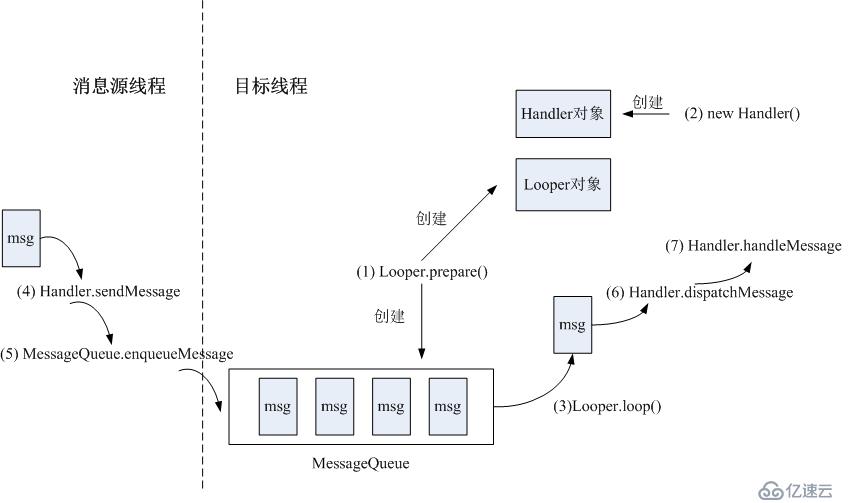您好,登錄后才能下訂單哦!
您好,登錄后才能下訂單哦!
上一篇博文給出了Android中基于Handler Looper機制實現線程間通信的兩個典型實例。本文將對該機制的基本原理進行較深入的研究。個人認為,學好Android編程最好的老師就是Android的源代碼,下面將基于Android-19的源碼進行分析,重點闡述分析思路。
要分析Handler Looper機制,自然想到去看Handler類和Looper類的源碼(分別位于Handler.java和Looper.java兩個文件中)。簡單閱讀兩個類的描述后,在Looper類的描述中能找到以下一段示例代碼。
* <p>This is a typical example of the implementation of a Looper thread,
* using the separation of {@link #prepare} and {@link #loop} to create an
* initial Handler to communicate with the Looper.
*
* <pre>
* class LooperThread extends Thread {
* public Handler mHandler;
*
* public void run() {
* Looper.prepare();
*
* mHandler = new Handler() {
* public void handleMessage(Message msg) {
* // process incoming messages here
* }
* };
*
* Looper.loop();
* }
* }</pre>
*/ 這段代碼給出了Handler Looper機制實現進程間通信的三大基本步驟,包括Looper的兩個函數prepare()和loop(),以及Handler的handleMessage函數。上一篇博文中實例二模擬子線程向UI主線程傳遞信息的程序就基本上是直接copy這段示例代碼實現的。
先看第一個步驟:調用Looper.prepare()函數,猜測應該是創建Looper對象,做些初始化工作。代碼如下:
/** Initialize the current thread as a looper.
* This gives you a chance to create handlers that then reference
* this looper, before actually starting the loop. Be sure to call
* {@link #loop()} after calling this method, and end it by calling
* {@link #quit()}.
*/
public static void prepare() {
prepare(true);
} 直接調用了重載函數prepare(true);
//ThreadLocal實例為多個線程共享,但保證每個線程的存儲空間相互獨立
static final ThreadLocal<Looper> sThreadLocal = new ThreadLocal<Looper>();
//消息隊列
final MessageQueue mQueue;
//當前線程引用
final Thread mThread;
private static void prepare(boolean quitAllowed) {
//保證一個線程最多只能創建一個Looper對象。
if (sThreadLocal.get() != null) {
throw new RuntimeException("Only one Looper may be created per thread");
}
//創建Looper對象并存儲到當前線程獨立的存儲空間中
sThreadLocal.set(new Looper(quitAllowed));
}
private Looper(boolean quitAllowed) {
//創建消息隊列(線程間即通過該消息隊列實現通信)
mQueue = new MessageQueue(quitAllowed);
//獲得當前線程的引用
mThread = Thread.currentThread();
}看到這里明白了,Looper的prepare函數實際上創建了Looper對象并把對象保存到當前線程獨立的存儲空間中。這里,Looper的構造函數是私有的,所以外部無法直接通過new Looper()隨意創建Looper對象。而只能通過Looper的prepare()函數創建。這樣做能夠保證對于某一個線程,最多只會創建一個Looper對象的實例,這實際上就是設計模擬中的單體模式。此外,在Looper的私有構造函數中還創建了消息隊列并獲得當前線程(即創建Looper的線程)的引用。
先跳過Handler.handleMessage(Message msg),直接看Looper.loop()的實現。
/**
* Run the message queue in this thread. Be sure to call
* {@link #quit()} to end the loop.
*/
public static void loop() {ui
//myLooper()函數通過sThreadLocal.get()判斷當前線程是否已經創建了Looper的實例
final Looper me = myLooper();
if (me == null) {
throw new RuntimeException("No Looper; Looper.prepare() wasn't called on this thread.");
}
final MessageQueue queue = me.mQueue;
// Make sure the identity of this thread is that of the local process,
// and keep track of what that identity token actually is.
Binder.clearCallingIdentity();
final long ident = Binder.clearCallingIdentity();
//這里開始無限循環
for (;;) {
//從消息隊列中取出一條消息
Message msg = queue.next(); // might block
if (msg == null) {
// No message indicates that the message queue is quitting.
return;
}
// This must be in a local variable, in case a UI event sets the logger
Printer logging = me.mLogging;
if (logging != null) {
logging.println(">>>>> Dispatching to " + msg.target + " " +
msg.callback + ": " + msg.what);
}
//這里是關鍵,調用了dispatchMessage函數對從消息隊列取出的msg進行分派
msg.target.dispatchMessage(msg);
if (logging != null) {
logging.println("<<<<< Finished to " + msg.target + " " + msg.callback);
}
// Make sure that during the course of dispatching the
// identity of the thread wasn't corrupted.
final long newIdent = Binder.clearCallingIdentity();
if (ident != newIdent) {
Log.wtf(TAG, "Thread identity changed from 0x"
+ Long.toHexString(ident) + " to 0x"
+ Long.toHexString(newIdent) + " while dispatching to "
+ msg.target.getClass().getName() + " "
+ msg.callback + " what=" + msg.what);
}
//消息使命完成,將其放回消息池
msg.recycle();
}
}到這里,Looper扮演的角色已經明朗了,主要就是通過loop()函數中的那個無限循環不斷從消息隊列中取出消息,并通過dispatchMessage()方法將消息派送出去。那么消息隊列中的消息從哪里來,又會被派送到哪里呢?
先來分析第一個問題,消息從哪里來。上一篇博文的實例中,消息源線程均通過調用Handler的sendMessage()函數來發送消息。進入Handler.java文件看其中的sendMessage()函數。
public final boolean sendMessage(Message msg)
{
return sendMessageDelayed(msg, 0);
}這里調用了sendMessageDelayed,延時0毫秒。
public final boolean sendMessageDelayed(Message msg, long delayMillis)
{
if (delayMillis < 0) {
delayMillis = 0;
}
return sendMessageAtTime(msg, SystemClock.uptimeMillis() + delayMillis);
} 進一步調用了sendMessageAtTime,在當前時刻發出。
public boolean sendMessageAtTime(Message msg, long uptimeMillis) {
//獲得消息隊列的引用
MessageQueue queue = mQueue;
if (queue == null) {
RuntimeException e = new RuntimeException(
this + " sendMessageAtTime() called with no mQueue");
Log.w("Looper", e.getMessage(), e);
return false;
}
return enqueueMessage(queue, msg, uptimeMillis);
} 再看enqueueMessage函數。
private boolean enqueueMessage(MessageQueue queue, Message msg, long uptimeMillis) {
//設置target handler
msg.target = this;
if (mAsynchronous) {
msg.setAsynchronous(true);
}
//將消息插入到消息隊列中
return queue.enqueueMessage(msg, uptimeMillis);
}看到這里已經明朗了,消息源線程通過Handler.sendMessage發送消息,實際上就是把消息插入了與之關聯的消息隊列中。在enqueueMessage函數中有一條關鍵語句msg.target = this,通過這條語句就把Handler和Looper關聯起來了(在Looper.loop()的循環中就是通過msg.target屬性找到發送消息的Handler并調用其dispatchMessage()函數派發消息的).
搞清楚了消息從哪里來,接下來分析消息被派發到哪里,接著看dispatchMessage()函數的實現。
/**
* Handle system messages here.
*/
public void dispatchMessage(Message msg) {
//若消息對象實現了其中的Runnable接口,調用對應的回調函數,即為message.callback.run())
if (msg.callback != null) {
handleCallback(msg);
} else {
//若實現了Handler類的Callback接口,調用接口的回調函數
if (mCallback != null) {
if (mCallback.handleMessage(msg)) {
return;
}
}
//將消息返回Handler的消息處理回調函數(是Handler的成員函數,示例代碼中回調的就是該函數)
handleMessage(msg);
}
}可見,dispatchMessage函數中根據msg,handler對象的設置情況調用相應的消息處理回調函數,我們只需要在這個回調函數中添加代碼,就可以進行消息處理。示例代碼的第二個步驟中的handleMessage函數就是在這里被回調的。
下面回到示例代碼中的第二個步驟:
* mHandler = new Handler() {
* public void handleMessage(Message msg) {
* // process incoming messages here
* }
* }; 這段代碼創建了Handler的對象,并覆蓋了其中的HandleMessage方法,用戶可以添加自己的消息處理函數。 handleMessage回調函數上面已經分析過了,下面主要看看創建handler對象時都做了哪些事情。轉入Handler.java文件,看Handler的構造函數(找不帶參數那個)。
/**
* Default constructor associates this handler with the {@link Looper} for the
* current thread.
*
* If this thread does not have a looper, this handler won't be able to receive messages
* so an exception is thrown.
*/
public Handler() {
this(null, false);
}調用了下面的雙參數的構造函數。
final Looper mLooper;
final MessageQueue mQueue;
public Handler(Callback callback, boolean async) {
if (FIND_POTENTIAL_LEAKS) {
final Class<? extends Handler> klass = getClass();
if ((klass.isAnonymousClass() || klass.isMemberClass() || klass.isLocalClass()) &&(klass.getModifiers() & Modifier.STATIC) == 0) {
Log.w(TAG, "The following Handler class should be static or leaks might occur: " +klass.getCanonicalName());
}
}
//獲得當前線程Looper對象的引用
mLooper = Looper.myLooper();
if (mLooper == null) {
throw new RuntimeException(
"Can't create handler inside thread that has not called Looper.prepare()");
}
//獲得Looper關聯的消息隊列
mQueue = mLooper.mQueue;
mCallback = callback;
mAsynchronous = async;
} 到這里發現Handler的構造函數主要做了兩件事:1)獲得當前線程Looper對象的應用.2)獲得與Looper關聯的消息隊列的引用。到這里,Handler、Looper、消息隊列三者就已經關聯起來了。
下面通過一個示意圖對上面的分析進行總結。

由圖可見,基于Handler Looper機制傳遞消息主要包括以下幾個步驟。
(1)目標線程調用Looper.prepare()創建Looper對象和消息隊列。
(2)目標線程通過new Handler()創建handler對象,將Handler,Looper,消息隊列三者關聯起來。并覆蓋其handleMessage函數。
(3)目標線程調用Looper.loop()監聽消息隊列。
(4)消息源線程調用Handler.sendMessage發送消息。
(5)消息源線程調用MessageQueue.enqueueMessage將待發消息插入消息隊列。
(6)目標線程的loop()檢測到消息隊列有消息插入,將其取出。
(7)目標線程將取出的消息通過Handler.dispatchMessage派發給Handler.handleMessage進行消息處理。
到這里整個Android的Handler Looper機制傳遞消息原理就分析完畢了。還有一個問題值得一提,回顧一下上一篇博文的示例1模擬從網絡上下載數據的程序,UI主線程只通過new Handler()創建了Handler對象的實例并覆蓋了其handleMessage函數。在代碼中并沒有看到調用Looper.prepare和Looper.loop(),那么UI主線程中沒有創建Looper對象嗎?下面就來分析這個問題,既然是UI主線程,那么自然是在啟動應用時候由系統自動創建的,創建過程中是否已經創建了Looper對象并調用loop()進行監聽了呢?轉到ActivityThread.java,找到其中的main函數,這里即為Android程序的入口。在其中能看到以下兩行代碼。
Looper.prepareMainLooper(); ...... ...... Looper.loop();
再看prepareMainLooper函數的實現:
public static void prepareMainLooper() {
prepare(false);
synchronized (Looper.class) {
if (sMainLooper != null) {
throw new IllegalStateException("The main Looper has already been prepared.");
}
sMainLooper = myLooper();
}
}在這里調用了prepare創建Looper對象。所以說,對于UI主線程而言,其Looper對象是由系統創建好的,用戶就無需自行創建了。
免責聲明:本站發布的內容(圖片、視頻和文字)以原創、轉載和分享為主,文章觀點不代表本網站立場,如果涉及侵權請聯系站長郵箱:is@yisu.com進行舉報,并提供相關證據,一經查實,將立刻刪除涉嫌侵權內容。